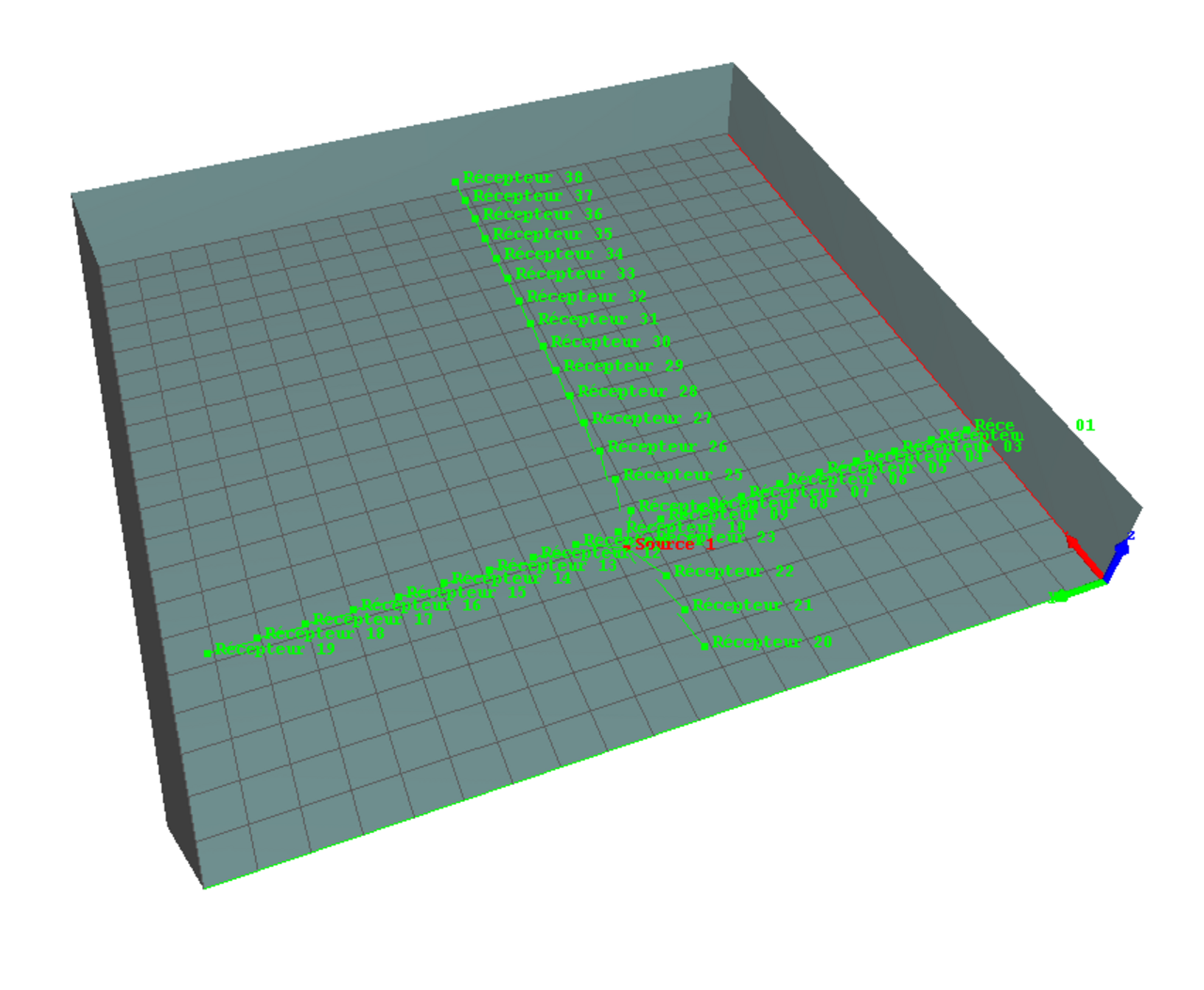All elements of this simulation are licensed under Licence Creative Commons Attribution 4.0 International License.
Low room with diffuse reflection and non-uniform absorption
Description
Academic case: Low room (20m x 20m x 5m) with 100% diffuse reflection and non- uniform surface absorption 5% for all walls excepted at wall located at y=20m (absorption 50%), with a single source at (4,10,1) and two lines of 19 punctual receivers at locations at z=1m along x=4.5m (R1 to R19) and y=9.5m (R20 to R38) with a spatial step of 1m.
What is tested?
Comparison between I-Simpa simulations (TCR, SPPS, MD) using the geometry described in [Valeau, 2006]. This allows to compare numerical results in a geometry that is not in agreement with the assumptions of a diffuse sound field (a low room with non-uniform absorption).
[Valeau, 2006] Valeau, V., Picaut, J., Hodgson, M. , "On the use of a diffusion equation for room-acoustic prediction", J. Acoust. Soc. Am. 119, 1504 (2006). doi.org/10.1121/1.2161433
CAUTION - The following results present comparisons between numerical simulations carried out with I-Simpa and 'reference' data available in the scientific literature.
- It is difficult to prejudge the concept of 'reference'. The deviation between the simulations and the reference data that can be observed do not necessarily call into question the corresponding simulations but can also be associated with other sources of deviation (modeling assumptions, numerical instabilities, experimental uncertainties, etc.).
- Note also that these comparaisons can also show the limitations of some numerical codes.
Results
In terms of sound level (total field), the SPPS and MD codes give similar results, showing a progressive decrease of sound levels (SL) along the room, while the TCR code, beyond the reverberation radius (i.e. the critical distance), gives a constant value. For the reverberation time (RT30), this agreement between SPPS and MD is still observed, while the TCR code give underestimated values. Both for the RT and SL, the diffusion model (MD) seems slightly overestimate the SPPS values. In summary, for such geometry that does not deal with diffuse sound field assumptions, the TCR code gives inaccurate results, while the SPPS and MD codes seem propose a better behavior.
Reference (copie 1)
| Parameters | Value |
|---|---|
| Active calculation of Atmospheric absorption | NO |
| Active calculation of diffusion by fitting objects | NO |
| Active calculation of direct field only | NO |
| Active calculation of transmission | NO |
| Calculation method | Energetic |
| Limit value of the particle extinction | 5.0 |
| Number of sound particles per source | 1 000 000 |
| Number of sound particles per source (display) | |
| Random initialization number | |
| Receiver radius | 0.31 |
| Simulation length (s) | 2.000 |
| Time step (s) | 0.01 |
Reference (copie 2)
| Parameters | Value |
|---|---|
| Active calculation of Atmospheric absorption | NO |
Reference (copie 3)
| Parameters (MD_Octave) | Value |
|---|---|
| Active calculation of Atmospheric absorption | NO |
| Merge with direct field | YES |
| Diffusion equation resolution - Maximum number of iterations | 200 |
| Diffusion equation resolution - Tolerance | 0.000001 |
| Simulation length (s) | 2.000 |
| Time step (s) | 0.001 |
What is tested?
Comparison between I-Simpa simulations (TCR, SPPS, MD) using the geometry described in [Valeau, 2006]. This allows to compare numerical results in a geometry that is not in agreement with the assumptions of a diffuse sound field (a low room with non-uniform absorption).
[Valeau, 2006] Valeau, V., Picaut, J., Hodgson, M. , "On the use of a diffusion equation for room-acoustic prediction", J. Acoust. Soc. Am. 119, 1504 (2006). doi.org/10.1121/1.2161433
Description
Academic case: Low room (20m x 20m x 5m) with 100% diffuse reflection and non- uniform surface absorption 5% for all walls excepted at wall located at y=20m (absorption 50%), with a single source at (4,10,1) and two lines of 19 punctual receivers at locations at z=1m along x=4.5m (R1 to R19) and y=9.5m (R20 to R38) with a spatial step of 1m.
All elements of this simulation are licensed under Licence Creative Commons Attribution 4.0 International License.


